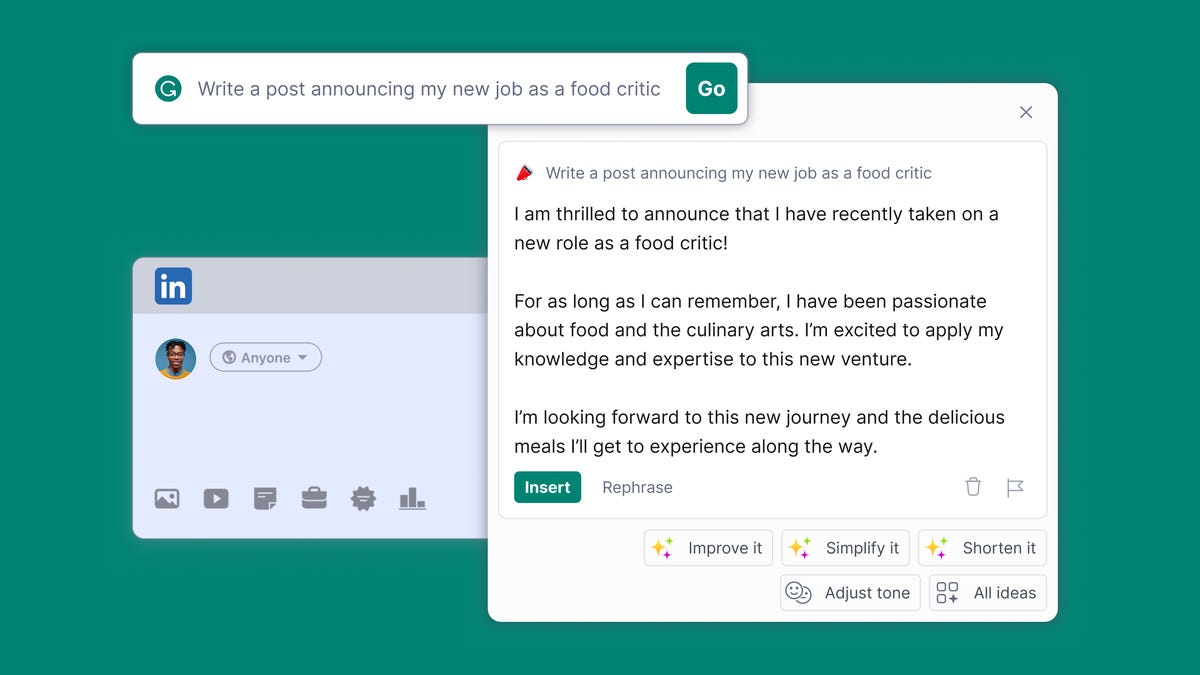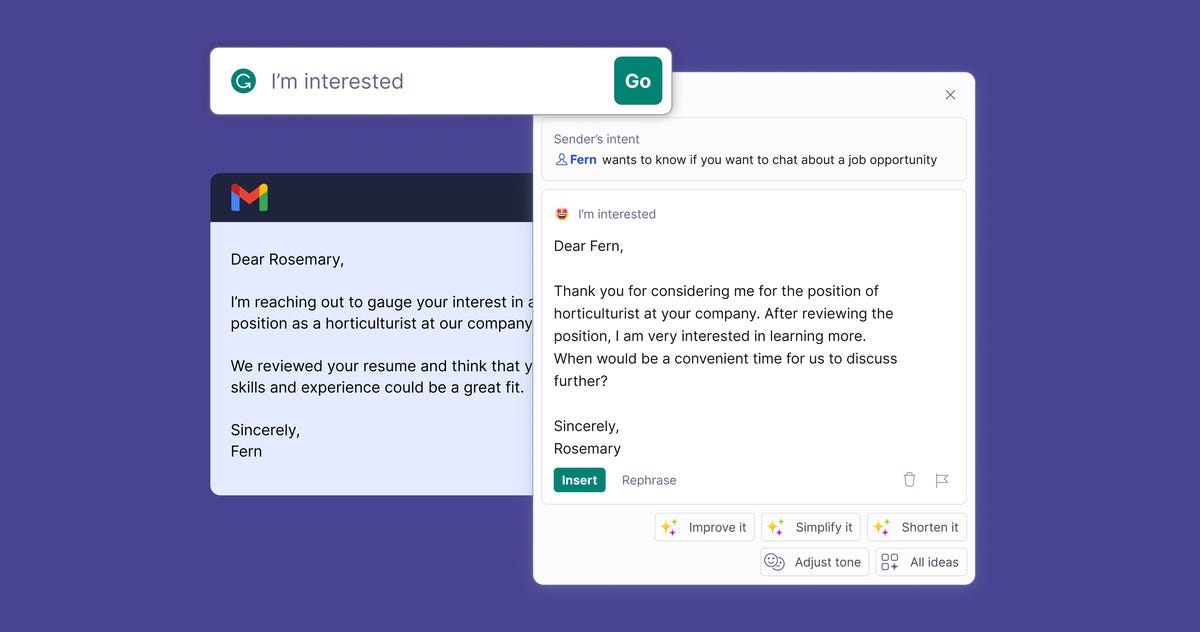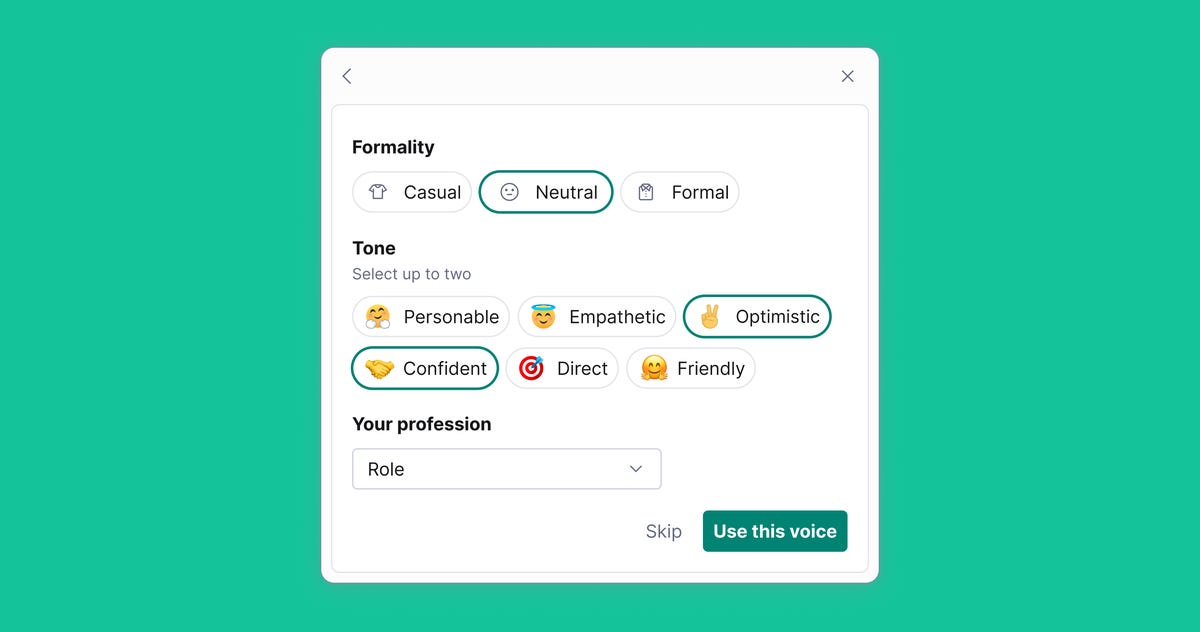Technologies
GrammarlyGo: What to Know About Grammarly’s New Generative AI Tool
The new tool will be available to most Grammarly users in April.

Grammarly, which offers a real-time spelling and grammar checking tool, is expanding its artificial intelligence resources with a new generative AI tool called GrammarlyGo that the company says is intended to improve communication. Most Grammarly users will be able to use it starting in April.
«Poor communication erodes relationships, stifles business growth and results, and slows feedback loops that devour our time, just to name a few effects,» Rahul Roy-Chowdhury, Grammarly’s global head of product, wrote in a blog post. «In research we conducted with The Harris Poll last year, we established that poor communication costs US businesses up to $1.2 trillion annually — or $12,506 per employee.» You can read the full report here.
According to Grammarly, GrammarlyGo will use personal, organizational and situational context to help craft messages for email, social media and long-form communication. That means if you use GrammarlyGo to write an interoffice message to your work team, the tool could help make your message sound more professional.
GrammarlyGo will give you prompts to improve, simplify or shorten a message, as well as a prompt to adjust the message’s tone for different scenarios. You’ll also be able to enter your own prompt to fit your needs.
GrammarlyGo can also be used to generate outlines or ideas, which can be added to messages or used as references. The tool will also have one-click prompts to help you get over writer’s block.


GrammarlyGo could step in to try to help you land that job you’re interested in.
Grammarly«By embracing new technologies like generative AI, we can advance our vision of supporting the entire process — from conception to comprehension,» Roy-Chowdhury wrote.
Grammarly is the latest tech company to announce an AI tool in the wake of OpenAI’s ChatGPT bursting onto the scene at the end of 2022. Other companies, like Microsoft, Google and Snapchat, have announced AI chatbot tools that a person can seemingly carry on a conversation with and that are poised to remake internet search and other familiar online activities, from writing essays to planning a week’s vacation to a new destination. These tools can also generate messages and ideas but don’t appear to take context into account when generating content.
GrammarlyGo’s ability to understand context and tone to a limited degree implies this AI tool is not only a generative AI but a very basic contextual AI, as well.
According to Techopedia, generative AI is an umbrella term that can apply to any type of AI that can be used to create things like text, images, video, audio and code. The technology company Symbl.ai writes that contextual AI can analyze cultural, historical and situational aspects of data to make the best decision.


Users need to give GrammarlyGo information about what kind of text they want the tool to create.
GrammarlyAccording to Grammalry, GrammarlyGo can understand situational context enough to create tailored communication for different scenarios. You still need to input certain data, like the level of formality and tone, into GrammarlyGo in order for it to create the right message. Although the tool may not intuitively be able to respond appropriately, it can differentiate between crafting a casual and formal response if it’s given the data.
GrammarlyGo will be available across other Grammarly products, like Grammarly Premium, Business, Education and Grammarly for Developers. Some Grammarly Free users in select markets will also be able to access GrammarlyGo.
For more, check out what to know about Google’s AI chatbot Bard, Microsoft’s AI-powered Bing and Snapchat’s MyAI.
Editors’ note: CNET is using an AI engine to create some personal finance explainers that are edited and fact-checked by our editors. For more, see this post.
Technologies
We’ve Found the Coolest, Most Futuristic Tech at CES 2026. And the Show Just Started
We’ve already had a day to trawl for our favorite cutting-edge technology. Neat stuff abounds!

We have people all over the show floor and beyond at CES, searching for the most interesting, innovative and cutting-edge tech available. A ton of useful new information is also available, which you can find on our CES 2026 live blog and in our CES hub.
The show floor opened Tuesday, and we had a lot of preview time beforehand to gawk at some CES staples, such as robots, electronic toys, phones and more. I’ll be back here to top off our fun finds regularly throughout the show.
Technologies
Grab This Tariff-Busting Xbox Series X Deal and Save $44 While You Can
You can bag a 1TB Xbox Series X for just $606, but act fast, since we don’t know how long this deal will last.

Ever since tariffs and other economic uncertainty led to Xbox price increases in late 2025, things have gotten expensive. A 1TB Xbox Series X now sells for $50 more than it used to, and there is little sign of these prices improving anytime soon.
Thankfully, every so often, a deal pops up that helps make things a little more affordable like this Walmart discount that slashes that same Series X to just $606. The catch? Well, there isn’t one. But we don’t expect this deal to last for long, so make sure to get your order in soon before it leaves for good.
The Xbox Series X has been around for a while now, so there are no surprises with what you get in the box. The Series X comes with a 1TB SSD for storage, and you get a controller in the box. This version also has a disc drive for installing games and watching Blu-ray movies, too.
Hey, did you know? CNET Deals texts are free, easy and save you money.
You can look forward to watching 4K content and playing 4K games, as well as enjoying audio options such as Dolby Digital, Dolby TrueHD and DTS. All of that makes this a capable machine, whether you want to watch content or play games.
CHEAP GAMING LAPTOP DEALS OF THE WEEK
Why this deal matters
It’s unlikely that Xbox prices will get any cheaper anytime soon, so deals like this are the best we can expect for a while now. If you’re in the market for an Xbox and have the $604 to spare, then this is probably the time to place your order before it’s too late.
Technologies
Dreaming of a Cable-Free World? I Think I Just Saw the Future of Wireless Power
This is the coolest thing I’ve seen at CES 2026. And it has nothing to do with AI.

Many technology companies arrive at CES 2026 in Las Vegas, the world’s biggest tech show. They often make bold claims about the life-changing potential of their innovations, but it’s rare to see anything that actually lives up to the hype.
When you do see something truly special, on the other hand, it can seem like magic. That’s exactly how I felt when I experienced the wireless charging demo from Finnish company Willo, a deep-tech startup that’s just emerged from stealth mode.
«Seeing is believing,» Willo co-founder and President Marko Voutilainen tells me as I take a seat in a Las Vegas hotel suite to witness what the company hopes will be a revolution in wireless power. It could render the charging cables that rule our lives and clog up our drawers obsolete for good.
Wireless power has long posed a conundrum to tech companies. There needs to be perfect alignment between a device and the charger, which means that it’s often just as convenient to simply plug a cable into your phone. Wireless charging today feels like a half-baked solution.
The tech that Willo showed me doesn’t rely on charging pads, line of sight, directional targeting or even immediate proximity. Instead, it allows devices to be charged simply by existing within the force field of the power source.
The demo I’m being shown looks unassuming. They tell me I shouldn’t get caught up too much with the form factor of the power source — a simple gray-white cube. This isn’t a consumer device that’s for sale, merely a means to demonstrate the technology to me.
Willo CEO Hari Santamala picks up several receivers, black boxes shaped like phones with LEDs on the top. As he moves them to within 15 inches or so of the power source, the LEDs light up. He moves them around the cube, rotating them in different directions. The LEDs remain lit.
I’m seeing. I’m believing.
Making power cables the floppy disks of tomorrow
Unfortunately, I’m not allowed to take any pictures or videos. This week at CES, Willo is emerging from stealth mode to show the world what it can do, but it’s still playing its cards close to its chest.
The core technology is based on more than a decade of research by the company co-founder and CTO Nam Ha-Van. The company is claiming a number of world firsts with its wireless power tech, including the ability to rotate devices at any angle while charging, along with the ability to charge multiple devices at once.
Santamala talks me through his vision for how it would exist in the home. «You have to build the transmitter in a way that it’s kind of a natural part of your environment,» he says. «Ideally, we don’t see any of this,» he adds, gesturing to the cube.
You could sit on the sofa with your phone in your pocket, and it would be quietly charging while you watch TV. If you were working from home, you could move freely around your house with your laptop, never having to worry about plugging it in.
«We want to do to power cables, what floppy disks are to us today,» Voutilainen says. «They’re remnants of the past.»
It feels like the thing we’ve been waiting for — the way wireless charging was always supposed to be. So when can we expect to get it?
Willo is here at CES meeting journalists like me, but also the kind of partners it will need to adopt this technology and take it out into the world. Voutilainen and Santamala are cagey about their ideal strategy for doing this, but it feels like they’re hinting towards something open and large-scale. Comparisons to Wi-Fi and Bluetooth are thrown around.
«This can really change our everyday lives if introduced correctly in a very kind of open and driving-the-market-forward kind of way,» Santamala says. The company’s tech is «pretty ready» for industrialization, he adds — it just depends on their partners’ use cases and timelines.
I depart from the demo suite, hoping that what I’ve seen is as viable as I’ve been led to believe. Willo clearly thinks it has something special on its hands, and if the rest of the tech industry agrees, this might just be the first step toward a future free of charging cable fuss and inconvenience.
-

 Technologies3 года ago
Technologies3 года agoTech Companies Need to Be Held Accountable for Security, Experts Say
-

 Technologies3 года ago
Technologies3 года agoBest Handheld Game Console in 2023
-

 Technologies3 года ago
Technologies3 года agoTighten Up Your VR Game With the Best Head Straps for Quest 2
-

 Technologies4 года ago
Technologies4 года agoBlack Friday 2021: The best deals on TVs, headphones, kitchenware, and more
-

 Technologies4 года ago
Technologies4 года agoGoogle to require vaccinations as Silicon Valley rethinks return-to-office policies
-

 Technologies4 года ago
Technologies4 года agoVerum, Wickr and Threema: next generation secured messengers
-

 Technologies4 года ago
Technologies4 года agoOlivia Harlan Dekker for Verum Messenger
-

 Technologies4 года ago
Technologies4 года agoiPhone 13 event: How to watch Apple’s big announcement tomorrow
